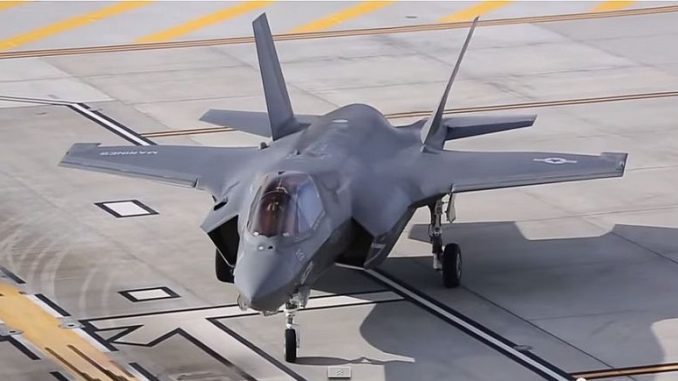
Video shows the new F-35 Lightning II multi-purpose aircraft demonstrating its short take-off and vertical landing capabilities.
The U.S. military’s new fighter jet is nearing its operational capability after initial testing. It could be used by the U.S. Navy, Marines and Air-force.
The F-35B is designed to be launched and to land on smaller aircraft carriers by using short take-off and vertical landing (STOVL). It could be launched from the end of a carriers’ deck using an upward ramp similar to a ski jump. This compensation in take-off length makes it a valuable tool for US and allied fleets to use on their numerous and less expensive smaller carriers.
Daily Military Defense & War Archive YouTube video:
F-35B Doing a Ski Jump Launch for the First Time in History + Vertical Landing Demonstration.

BYPASS THE CENSORS
Sign up to get unfiltered news delivered straight to your inbox.
You can unsubscribe any time. By subscribing you agree to our Terms of Use
Latest Video
The F-35 Lightning II (also known as the Joint Strike Fighter or JSF) is a multirole aircraft project conceived and developed by the Pentagon since 1996 by manufacturer Lockheed Martin, with the principal partners Northrop Grumman and BAE Systems.
Launched with the idea to equip the same device three air components of the US military (USAF, US Navy and US Marine Corps), a NATO dozen were invited to participate in its funding and its realization. This aircraft should be produced to over 2,000 copies and distributed mainly in the United States, Canada and the UK.
The development program, which did not provide a series of prototypes, has already accumulated a significant delay (7 years) compared to initial7 schedule and over budget estimated at 68% in July 2014. Seven years after theft in 2007 the first production model, none of the 131 purchased and delivered equipment is not yet operational, and the manufacturer recognizes the existence of numerous technical problems.
Sputnik News reports:
To simulate the decks, the tests at the Naval Air Station (NAS) Patuxent River in Maryland used a ramp fitted to the decommissioned HMS Illustrious of the Royal Navy. Currently the British, Italians and Australians are also considering purchasing the US Marines’ variant of the joint strike fighter.
The British have also been leading the way in coming up with new technologies for using the F-35B at sea, such as developing a system of flight deck lights that help pilots focus on a moving ship deck to ease their landings.
Those vertical landings were also tested earlier this month aboard the ISS Wasp multipurpose assault ship.
The concept behind the STOVL system was inspired by the UK’s Sea Harrier jets, but eliminated the need for pilots to manually rotate the jet’s exhaust nozzles, Peter ‘Wizzer’ Wilson, chief test pilot for BAE Systems, told IHS Jane’s Defense Weekly.
Vertical take-off means the jet can launch with more fuel and weapons on board, and using a smaller space. The maneuver also gives pilots more time, which means better safety.
“The real benefit is one of timing,” Wilson said. “Once airborne, you are flying upwards rather than horizontal, and this gives you extra time to think if something should go wrong.”
The F-35B is one of three variants of the fighter, and the first slated to reach initial operating capability (IOC), this summer. The F-35A is destined for the Air Force, and the F-35C is for the US Navy.
The F-35 program has been plagued with delays and astronomical cost overruns since the Pentagon started development in 2001.
So far $400 billion has been spent, and 140 of the projected 2,443 jets ordered by the US military have been delivered. The projected costs to complete and then maintain the F-35 fleet now tops a cool $1 trillion. Five aircraft have been delivered to foreign military buyers.
There have been concerns about engine reliability, various software systems problems, and difficulties integrating different weapons systems into different variants.
Indeed, the Marines’ F-35B is reaching IOC first of the three partially because it will not integrate a full suite of weapons. And the Air Force’s F-35A, when it technically reaches IOC, will not be equipped with either its high-definition synthetic aperture radar known as “BIG SAR” or a weapon known as the Small Diameter Bomb II.
The #F35 #lightning2 might have a lot of naysayers but she sure is pretty. #fighterjet #plane #aviation #AirForce #… pic.twitter.com/FJ2mhGBrXb
— Jack Silkstone (@JSilkstone) June 24, 2015


